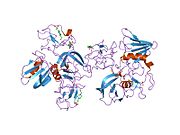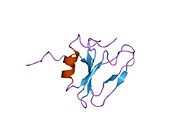Hepatocyte growth factor
Template:PBB Hepatocyte growth factor/scatter factor (HGF/SF) is a paracrine cellular growth, motility and morphogenic factor. It is secreted by mesenchymal cells and targets and acts primarily upon epithelial cells and endothelial cells, but also acts on haemopoietic progenitor cells and T cells. It has been shown to have a major role in embryonic organ development, specifically in myogenesis, in adult organ regeneration and in wound healing.[1]
Function
Hepatocyte growth factor regulates cell growth, cell motility, and morphogenesis by activating a tyrosine kinase signaling cascade after binding to the proto-oncogenic c-Met receptor.[2][3] Hepatocyte growth factor is secreted by mesenchymal cells and acts as a multi-functional cytokine on cells of mainly epithelial origin. Its ability to stimulate mitogenesis, cell motility, and matrix invasion gives it a central role in angiogenesis, tumorogenesis, and tissue regeneration.[4]
Structure
It is secreted as a single inactive polypeptide and is cleaved by serine proteases into a 69-kDa alpha-chain and 34-kDa beta-chain. A disulfide bond between the alpha and beta chains produces the active, heterodimeric molecule. The protein belongs to the plasminogen subfamily of S1 peptidases but has no detectable protease activity.[4]
Clinical significance
Human HGF plasmid DNA therapy of cardiomyocytes is being examined as a potential treatment for coronary artery disease as well as treatment for the damage that occurs to the heart after myocardial infarction.[5][6] As well as the well-characterised effects of HGF on epithelial cells, endothelial cells and haemopoietic progenitor cells, HGF also regulates the chemotaxis of T cells into heart tissue. Binding of HGF by cMet, expressed on T cells, causes the upregulation of cMet, CXCR3, and CCR4 which in turn imbues them with the ability to migrate into heart tissue.[7]
HGF may further play a role as an indicator for prognosis of chronicity for Chikungunya virus induced arthralgia. High HGF levels correlate with high rates of recovery.[8]
Excessive local expression of HGF, along with insulin-like growth factor 1 (IGF-1) to a lesser extent, in the breasts has been associated with macromastia.[9] HGF is also importantly involved in normal mammary gland development.[10][11]
HGF has been implicated in a variety of cancers, including of the lungs, pancreas, thyroid, colon, and breast.[12][13][14]
Circulating plasma levels
Plasma from patients with advanced heart failure presents increased levels of HGF, which correlates with a negative prognosis and a high risk of mortality. [15][16] Circulating HGF has been also identified as a prognostic marker of severity in patients suffering from hypertension. [17][18] Circulating HGF has been also suggested as a precocious biomarker for the acute phase of bowel inflammation. [19]
Pharmacokinetics
Exogenous HGF administered by intravenous injection is cleared rapidly from circulation by the liver, with a half-life of approximately 4 minutes.[20][21][22][23]
Interactions
Hepatocyte growth factor has been shown to interact with the protein product of the C-Met oncogene, identified as the HGF receptor (HGFR).[2][24][25] Both overexpression of the Met/HGFR receptor protein and autocrine activation of Met/HGFR by simultaneous expression of the hepatocyte growth factor ligand have been implicated in oncogenesis.[26][27]
See also
- growth factor
- hepatocyte growth factor receptor (HGFR)
References
- ^ Gallagher, J.T., Lyon, M. (2000). "Molecular structure of Heparan Sulfate and interactions with growth factors and morphogens". In Iozzo, M, V. (ed.). Proteoglycans: structure, biology and molecular interactions. Marcel Dekker Inc. New York, New York. pp. 27–59.
{{cite book}}: CS1 maint: multiple names: authors list (link) - ^ a b Bottaro DP, Rubin JS, Faletto DL, Chan AM, Kmiecik TE, Vande Woude GF, Aaronson SA (Feb 1991). "Identification of the hepatocyte growth factor receptor as the c-met proto-oncogene product". Science. 251 (4995): 802–4. doi:10.1126/science.1846706. PMID 1846706.
- ^ Johnson M, Koukoulis G, Matsumoto K, Nakamura T, Iyer A (Jun 1993). "Hepatocyte growth factor induces proliferation and morphogenesis in nonparenchymal epithelial liver cells". Hepatology. 17 (6): 1052–61. doi:10.1016/0270-9139(93)90122-4. PMID 8514254.
- ^ a b "Entrez Gene: HGF hepatocyte growth factor (hepapoietin A; scatter factor)".
- ^ Yang ZJ, Zhang YR, Chen B, Zhang SL, Jia EZ, Wang LS, Zhu TB, Li CJ, Wang H, Huang J, Cao KJ, Ma WZ, Wu B, Wang LS, Wu CT (Jul 2009). "Phase I clinical trial on intracoronary administration of Ad-hHGF treating severe coronary artery disease". Molecular Biology Reports. 36 (6): 1323–9. doi:10.1007/s11033-008-9315-3. PMID 18649012.
- ^ Hahn W, Pyun WB, Kim DS, Yoo WS, Lee SD, Won JH, Shin GJ, Kim JM, Kim S (Oct 2011). "Enhanced cardioprotective effects by coexpression of two isoforms of hepatocyte growth factor from naked plasmid DNA in a rat ischemic heart disease model". The Journal of Gene Medicine. 13 (10): 549–55. doi:10.1002/jgm.1603. PMID 21898720.
- ^ "Hepatocyte Growth Factor Receptor c-Met Instructs T Cell Cardiotropism and Promotes T Cell Migration to the Heart via Autocrine Chemokine Release". Immunity. 42 (6): 1087–99. Jun 2015. doi:10.1016/j.immuni.2015.05.014. PMC 4510150. PMID 26070483.
{{cite journal}}: Unknown parameter|authors=ignored (help) - ^ Chow A, Her Z, Ong EK, Chen JM, Dimatatac F, Kwek DJ, Barkham T, Yang H, Rénia L, Leo YS, Ng LF (Jan 2011). "Persistent arthralgia induced by Chikungunya virus infection is associated with interleukin-6 and granulocyte macrophage colony-stimulating factor". The Journal of Infectious Diseases. 203 (2): 149–57. doi:10.1093/infdis/jiq042. PMC 3071069. PMID 21288813.
- ^ Zhong A, Wang G, Yang J, Xu Q, Yuan Q, Yang Y, Xia Y, Guo K, Horch RE, Sun J (Jul 2014). "Stromal-epithelial cell interactions and alteration of branching morphogenesis in macromastic mammary glands". Journal of Cellular and Molecular Medicine. 18 (7): 1257–66. doi:10.1111/jcmm.12275. PMID 24720804.
- ^ Niranjan B, Buluwela L, Yant J, Perusinghe N, Atherton A, Phippard D, Dale T, Gusterson B, Kamalati T (1995). "HGF/SF: a potent cytokine for mammary growth, morphogenesis and development". Development. 121 (9): 2897–908. PMID 7555716.
- ^ Kamalati T, Niranjan B, Yant J, Buluwela L (1999). "HGF/SF in mammary epithelial growth and morphogenesis: in vitro and in vivo models". J Mammary Gland Biol Neoplasia. 4 (1): 69–77. PMID 10219907.
- ^ Thomas R. Ziegler; Glenn F. Pierce; David N. Herndon (6 December 2012). Growth Factors and Wound Healing: Basic Science and Potential Clinical Applications. Springer Science & Business Media. pp. 311–. ISBN 978-1-4612-1876-0.
- ^ Sheen-Chen SM, Liu YW, Eng HL, Chou FF (Mar 2005). "Serum levels of hepatocyte growth factor in patients with breast cancer". Cancer Epidemiology, Biomarkers & Prevention. 14 (3): 715–7. doi:10.1158/1055-9965.EPI-04-0340. PMID 15767355.
- ^ El-Attar HA, Sheta MI (2011). "Hepatocyte growth factor profile with breast cancer". Indian Journal of Pathology & Microbiology. 54 (3): 509–13. doi:10.4103/0377-4929.85083. PMID 21934211.
{{cite journal}}: CS1 maint: unflagged free DOI (link) - ^ "A multi-biomarker risk score improves prediction of long-term mortality in patients with advanced heart failure". International Journal of Cardiology. 168 (2): 1251–7. Sep 2013. doi:10.1016/j.ijcard.2012.11.052. PMID 23218577.
{{cite journal}}:|first2=missing|last2=(help);|first3=missing|last3=(help); More than one of author-name-list parameters specified (help) - ^ "Hepatocyte growth factor is a strong predictor of mortality in patients with advanced heart failure". Heart. 97 (14): 1158–63. Jul 2011. doi:10.1136/hrt.2010.220228. PMID 21572126.
{{cite journal}}:|first2=missing|last2=(help);|first3=missing|last3=(help); More than one of author-name-list parameters specified (help) - ^ "Hepatocyte growth factor as a potential index of complication in diabetes mellitus". Journal of Hypertension. 16 (12 Pt 2): 2019–26. Dec 1998. PMID 9886892.
{{cite journal}}:|first2=missing|last2=(help);|first3=missing|last3=(help); More than one of author-name-list parameters specified (help) - ^ Morishita, Ryuichi; Moriguchi, Atsushi; Higaki, Jitsuo; Ogihara, Toshio (1999-01-01). "Hepatocyte Growth Factor (HGF) as a Potential Index of Severity of Hypertension". Hypertension Research. 22 (3): 161–167. doi:10.1291/hypres.22.161.
- ^ "Evaluation of hepatocyte growth factor as a local acute phase response marker in the bowel: the clinical impact of a rapid diagnostic test for immediate identification of acute bowel inflammation". Cytokine. 71 (1): 8–15. Jan 2015. doi:10.1016/j.cyto.2014.07.255. PMID 25174881.
{{cite journal}}:|first2=missing|last2=(help);|first3=missing|last3=(help); More than one of author-name-list parameters specified (help) - ^ Yang J, Chen S, Huang L, Michalopoulos GK, Liu Y (Apr 2001). "Sustained expression of naked plasmid DNA encoding hepatocyte growth factor in mice promotes liver and overall body growth". Hepatology. 33 (4): 848–59. doi:10.1053/jhep.2001.23438. PMID 11283849.
- ^ Appasamy R, Tanabe M, Murase N, Zarnegar R, Venkataramanan R, Van Thiel DH, Michalopoulos GK (Mar 1993). "Hepatocyte growth factor, blood clearance, organ uptake, and biliary excretion in normal and partially hepatectomized rats". Laboratory Investigation; A Journal of Technical Methods and Pathology. 68 (3): 270–6. PMID 8450646.
- ^ Kato, Yukio; Liu, Ke-Xin; Nakamura, Toshikazu; Sugiyama, Yuichi (1994). "Heparin-hepatocyte growth factor complex with low plasma clearance and retained hepatocyte proliferating activity". Hepatology. 20 (2): 417–424. doi:10.1002/hep.1840200223. ISSN 0270-9139.
- ^ Yu Y, Yao AH, Chen N, Pu LY, Fan Y, Lv L, Sun BC, Li GQ, Wang XH (Jul 2007). "Mesenchymal stem cells over-expressing hepatocyte growth factor improve small-for-size liver grafts regeneration". Molecular Therapy. 15 (7): 1382–9. doi:10.1038/sj.mt.6300202. PMID 17519892.
- ^ Comoglio PM (1993). "Structure, biosynthesis and biochemical properties of the HGF receptor in normal and malignant cells". Exs. 65: 131–65. PMID 8380735.
- ^ Naldini L, Weidner KM, Vigna E, Gaudino G, Bardelli A, Ponzetto C, Narsimhan RP, Hartmann G, Zarnegar R, Michalopoulos GK (Oct 1991). "Scatter factor and hepatocyte growth factor are indistinguishable ligands for the MET receptor". The EMBO Journal. 10 (10): 2867–78. PMC 452997. PMID 1655405.
- ^ Johnson M, Koukoulis G, Kochhar K, Kubo C, Nakamura T, Iyer A (Sep 1995). "Selective tumorigenesis in non-parenchymal liver epithelial cell lines by hepatocyte growth factor transfection". Cancer Letters. 96 (1): 37–48. doi:10.1016/0304-3835(95)03915-j. PMID 7553606.
- ^ Kochhar KS, Johnson ME, Volpert O, Iyer AP (1995). "Evidence for autocrine basis of transformation in NIH-3T3 cells transfected with met/HGF receptor gene". Growth Factors. 12 (4): 303–13. doi:10.3109/08977199509028968. PMID 8930021.
Further reading
- Michalopoulos GK, Zarnegar R (1992). "Hepatocyte Growth Factor". Hepatology. 15 (1): 149–54. doi:10.1002/hep.1840150125.
- Nakamura T (1992). "Structure and function of hepatocyte growth factor". Progress in Growth Factor Research. 3 (1): 67–85. doi:10.1016/0955-2235(91)90014-U. PMID 1838014.
- Ware LB, Matthay MA (May 2002). "Keratinocyte and hepatocyte growth factors in the lung: roles in lung development, inflammation, and repair". American Journal of Physiology. Lung Cellular and Molecular Physiology. 282 (5): L924-40. doi:10.1152/ajplung.00439.2001. PMID 11943656.
- Funakoshi H, Nakamura T (Jan 2003). "Hepatocyte growth factor: from diagnosis to clinical applications". Clinica Chimica Acta; International Journal of Clinical Chemistry. 327 (1–2): 1–23. doi:10.1016/S0009-8981(02)00302-9. PMID 12482615.
- Skibinski G (2004). "The role of hepatocyte growth factor/c-met interactions in the immune system". Archivum Immunologiae Et Therapiae Experimentalis. 51 (5): 277–82. PMID 14626426.
- Kalluri R, Neilson EG (Dec 2003). "Epithelial-mesenchymal transition and its implications for fibrosis". The Journal of Clinical Investigation. 112 (12): 1776–84. doi:10.1172/JCI20530. PMC 297008. PMID 14679171.
- Hurle RA, Davies G, Parr C, Mason MD, Jenkins SA, Kynaston HG, Jiang WG (Oct 2005). "Hepatocyte growth factor/scatter factor and prostate cancer: a review". Histology and Histopathology. 20 (4): 1339–49. PMID 16136515.
- Kemp LE, Mulloy B, Gherardi E (Jun 2006). "Signalling by HGF/SF and Met: the role of heparan sulphate co-receptors". Biochemical Society Transactions. 34 (Pt 3): 414–7. doi:10.1042/BST0340414. PMID 16709175.
External links
- Hepatocyte+growth+factor at the U.S. National Library of Medicine Medical Subject Headings (MeSH)
- Hepatocyte growth factor on the Atlas of Genetics and Oncology
- UCSD Signaling Gateway Molecule Page on HGF








